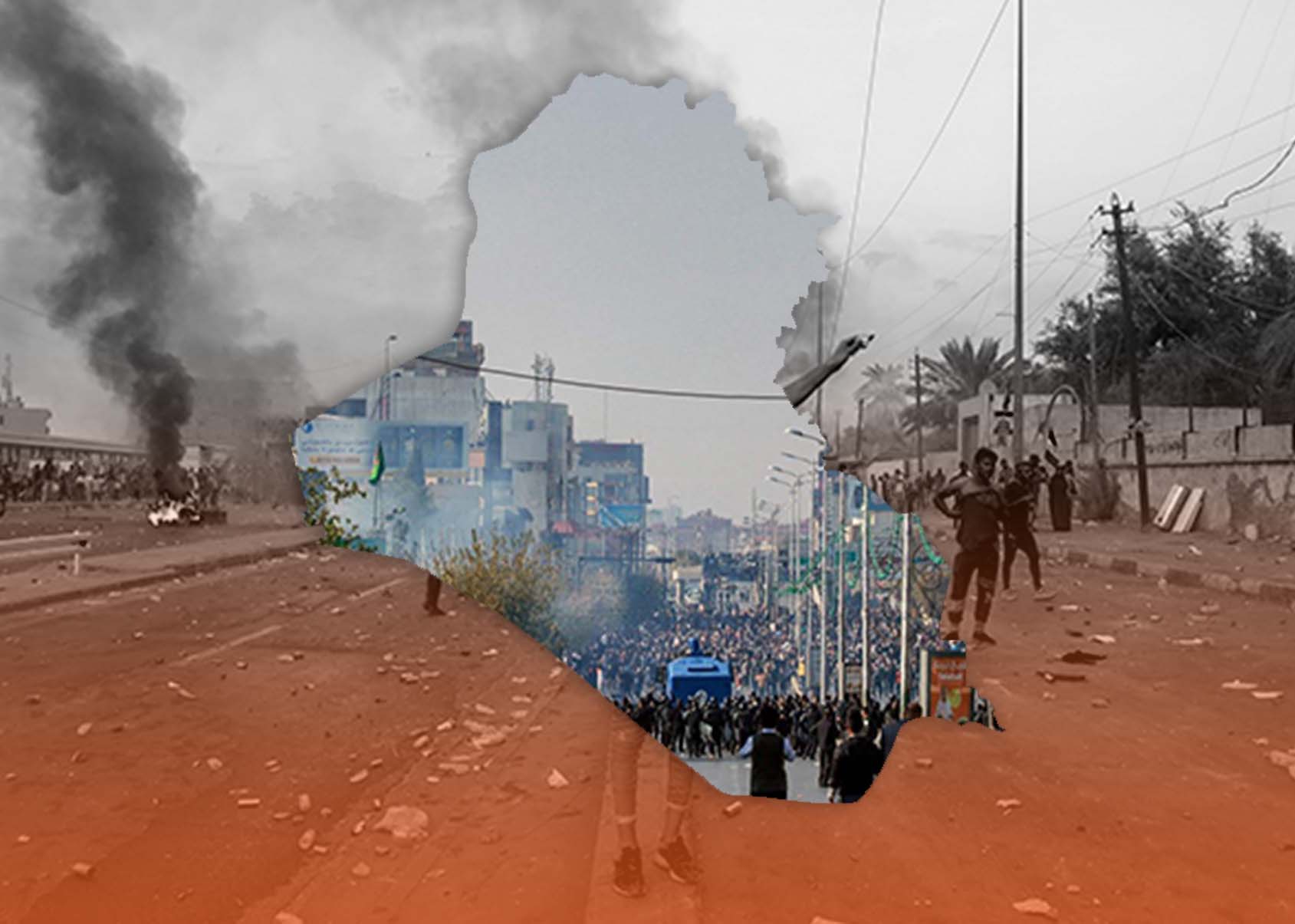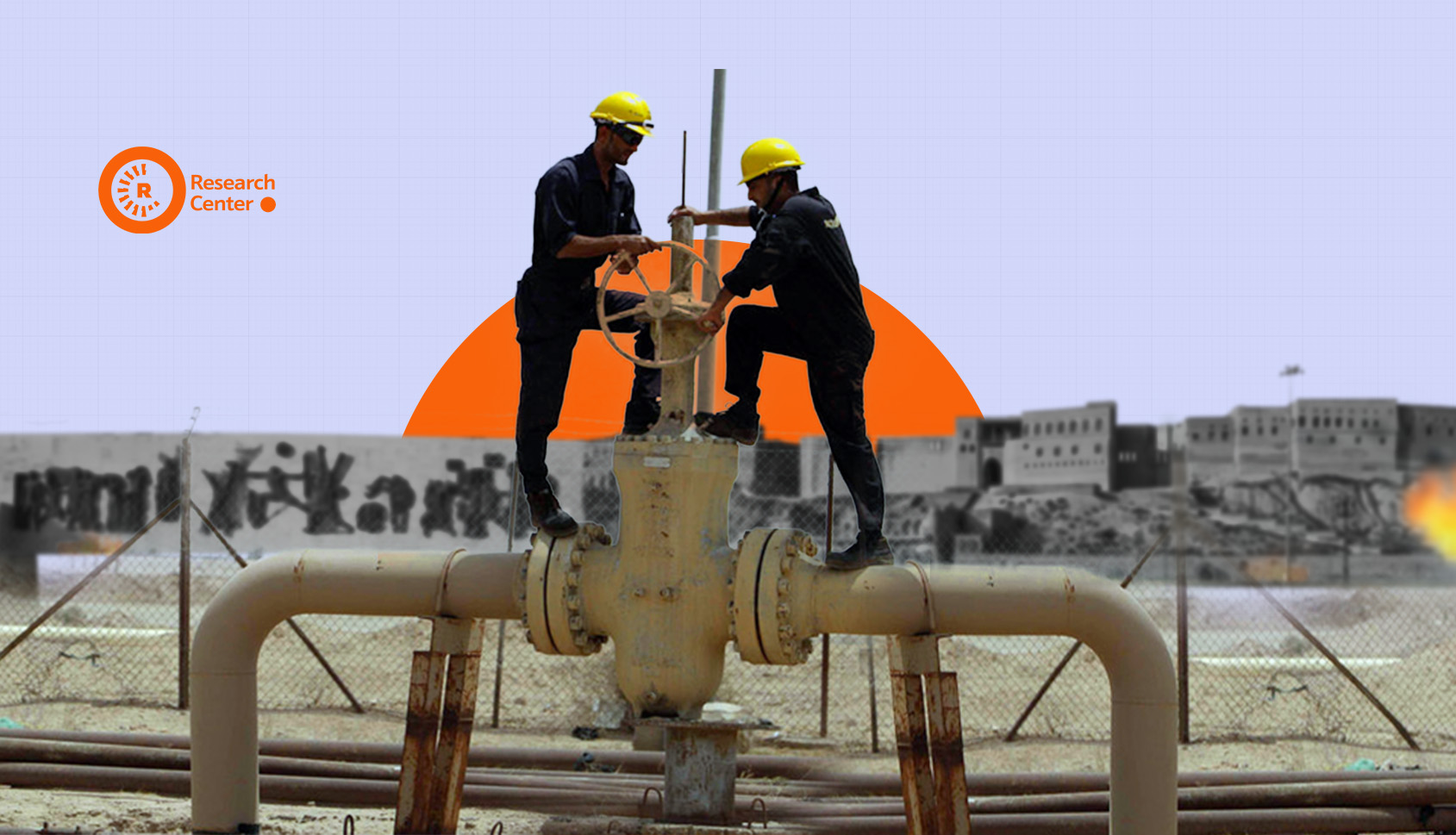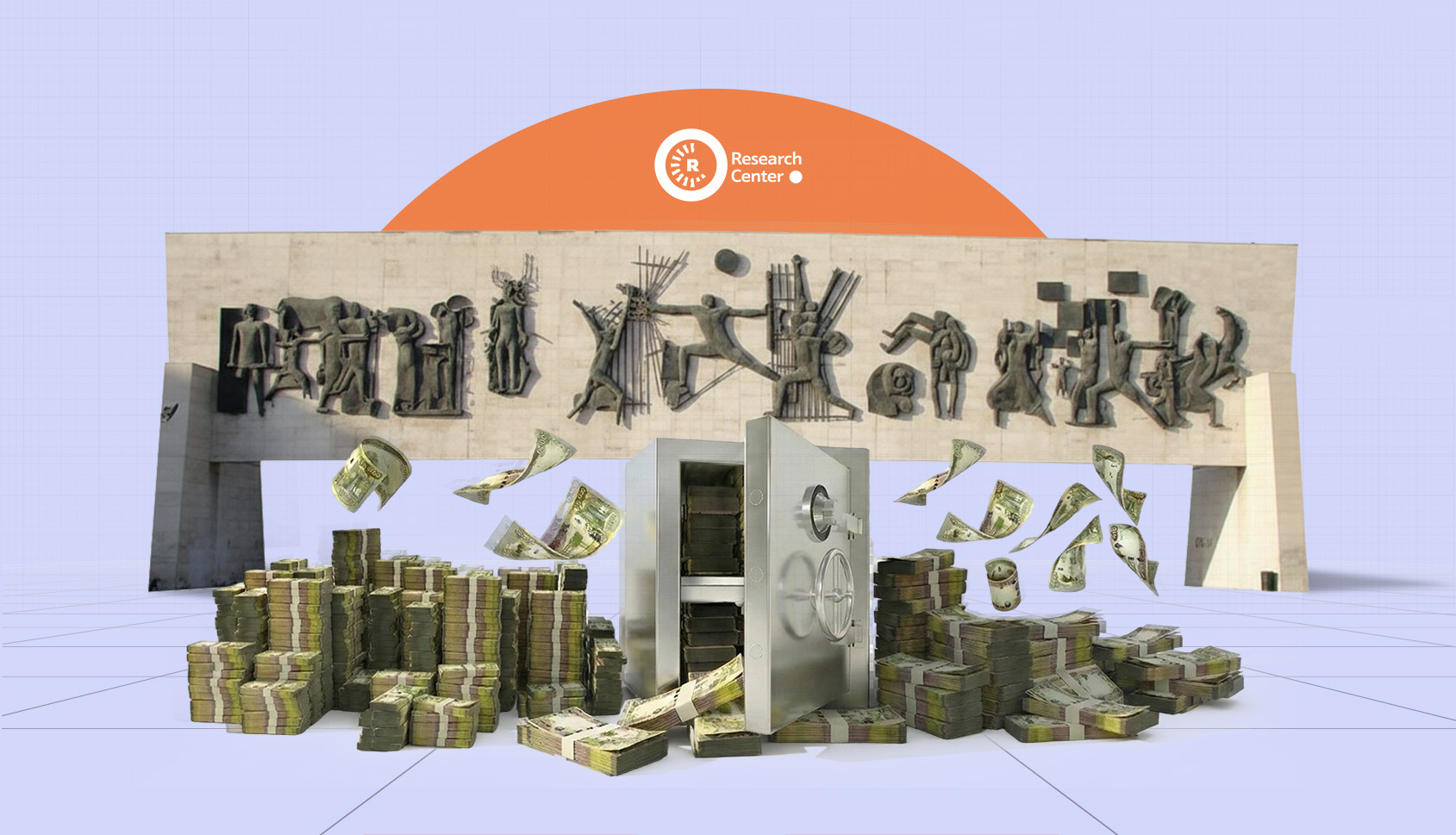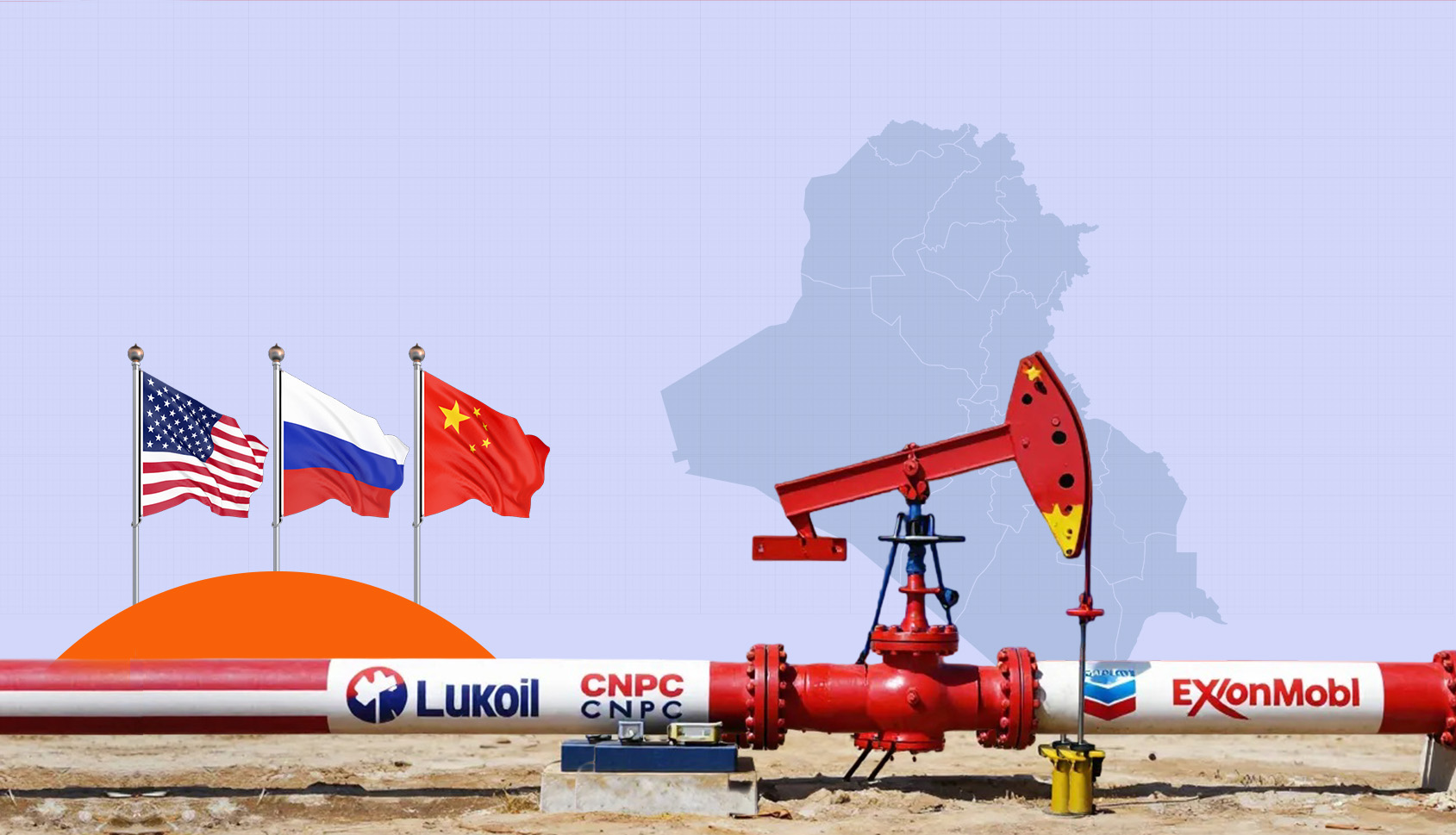Save for later
The toll is heavy: between the 1st of October and the 31st of December 2019, the number of deaths amounted to 669, the number of wounded to 24 488, and the number of arrestations to 29 8061. Assassination, abductions, hostage-taking, incarceration, torture, individual and family threats: the movement, generally peaceful, was defenseless in front of a power that killed wit19h no restraints2.
The rise in power of the protest movement and the radicalization of the repression bring us to ask ourselves about the situation of a state characterized by two major and decisive phenomena, which are widespread corruption3 and the systematization of milicization4. They also bring us to ask ourselves about the actors who are militating with a strong desire for an exit, whether gentle or brutal, out of what we now call the “militia-state” and for a better future.
In the perspective of elaborating a framework which could enable us to understand the complexity of the Iraqi situation, we will first reflect on the Iraqi political system, seen by the protest movement as being the main factor of the current crisis.
Then, we will focus on the identity markers of the protests which has unsettled a privileged class who thought itself eternal in its position of highest power, a class in total rupture with the social base of the tragically unfavored.
After which we will underline the heterogeneity of the protest movement and the different actors that compose it, with their vision of the strife against the militia-state and their paradigms of the actions envisioned as feasible.
The next part will undertake the notion of the militia-state’s « legitimate » violence against the actors of the protest movement. We will also take on the notion of foreign interference (of the United States of America) as well as regional (with the Islamic Republic of Iran), regarding violence management.
Finally, we will study different possible exits out of the dead end which both the militia-state and the protest movement are finding themselves in.
1 – The Iraqi Political System Functioning
The rebuilding of the Iraqi state starting 2003 after the occupation of country by the United States of America and their allies is based on a highly politicized communitarianism and a Shiite domination.
This system has been internalized by the political elite although there are no legal texts regarding the communitarian distribution. 50% of positions, such as the Prime Minister’s, belongs to the Shiite community. 25% belongs to the Sunni community, such as parliament speaker. Finally, 20% belongs to the Kurds, such as the President’s, and 5% belongs to other minorities5.
Although, since the creation of the Iraqi state by Britain in 1921, until its fall in 2003 following the US invasion, a disavowed communitarianism was found at the heart of institutions, and the Sunni community, deemed too arrogant by king Faysal, hogged all the political representation in the country. However, one must admit that starting 2003, new Iraqi elites started developing a narrative on the Iraqi society’s “components” that will have to “partner up” to manage the State. In practice, not only did this teaming up fail, but “de-Baathification” law voted of the 12th of May 2003, proposed by the Coalition Provisional Authority under the direction of Paul Bremer, will objectively exclude significant Sunni representation in the Iraqi state6.
In revolt against both the US occupation and the Shiite domination of the Iraqi state, the Sunni territory is gradually becoming a permanent battleground. In 2014, the Islamic State organization established its Caliphate in Mosul. The International Coalition against Daesh7, led by the United States of America, put down the Caliphate in 2017. Since the brutal and brutalizing fall of Daesh, the Sunnis have been mobilizing, with the encouragement of the International Coalition, to recover the 25% of positions that are theirs. Thus, they actively participated in the elections of May 12, 2018 and those of October 10, 2021, establishing themselves as an important player in the management of the state.
Since 1991, the Kurds in the North have been developing a state entity known and recognized as the Kurdistan Regional Government (KRG). With a President, Parliament, Government, Army, Court of Justice, international relations, economic system, territory and population, the KRG is more like a state within a state than a federated entity. The Kurds not only run the territory of the KRG solely, but they also hold 20 per cent of the positions in the Iraqi state.
This reminder is essential, as it allows us to clarify the identity markers of a protest movement in progress since October 1, 2019.
2 - Identity Markers of the Protest Movement
A mapping of the number of people killed, wounded or arrested in each province shows that the protest movement, in its current phase, is neither sectarian (Shiites against Sunnis or vice versa) nor ethnic (Arabs against Kurds or vice versa). For the first time since 2003, it is a Shiite social base that is angry at Shiite ruling elites for failing to provide a dignified life for the Shiite population in the south, a territory that supplies 80 per cent of Iraq's oil. Of the 669 dead and 24,488 wounded, not a single one was in the Sunni or Kurdish provinces.

This is an unprecedented situation! Certainly, the movement is not national, but neither is it the bearer of community issues. Indeed, the central conflict of the Movement is that of the protest against a system that has adopted corruption as a mode of operation of a profoundly fragile State. It is corruption, the "mother of all Iraqi plagues," that is denounced as a priority. According to official figures, the equivalent of some 410 billion euros of public money has been swallowed up since 2004, disappearing into the pockets of politicians of all stripes, tribal chiefs and businessmen. A staggering sum that represents four times the annual budget of the State8.”
The conflict is also that of the struggle against the process of "milicization" of the State, but especially that of Iraqi society as a way out of misery. The concept of the militia-state allows us to conduct a profound reflection on the central question of the construction of a state and society in its relation with militias. In the case of Iraq, the militias do not dispute the state's monopoly on legitimate violence - which could be the case in Lebanon, for example - because since 2003, the US has rebuilt the Iraqi state through and by them. The militias are officially integrated into all state institutions, including the armed forces and security forces. On May 12, 2003, the Coalition Provisional Authority (CPA) led by Paul Bremer issued Order No. 1 (De-Baathification of Iraqi Society) and Order No. 2, both prepared by the Pentagon... Order No. 2 entitled "Dissolution of Entities" dissolves the Iraqi army, security and intelligence services and also dismisses the employees of the Ministry of Defense9.
To fill this void, the militias of the former opposition parties to Saddam Hussein's regime became the ideal candidates. Thus, the first step towards the refoundation of Iraq on the model of the militia state has been taken. This model reached its peak with the famous fatwa issued on June 13, 2014 by Ayatollah Ali al-Sistani, the highest Shiite religious authority in Iraq10. Sistani had called on Iraqis to engage massively in the war against the Islamic State organization. The 80 militia groups structured in the Popular Mobilization organization clearly played an important role in defeating the Caliphate. However, it must be noted that, at the same time, they are becoming a vast market offering jobs, salaries, social recognition and prospects towards political and institutional inclusions.
Widespread corruption and the systematization of milicization are the two major factors that have created the perfect conditions for a profound rupture between a social base deprived of all rights and a ruling elite drowned in privileges. Among the population aged 15 and over, 11,806,855 people are illiterate11 ! The International Monetary Fund (IMF) states that the unemployment rate of Iraqi youth is over 40%. According to the IMF, the rate of women out of the labor force in Iraq is about 85%12. The Iraqi military state is in a situation of almost total bankruptcy in the areas that cover basic needs: drinking water, electricity, roads, etc. Within this context, 85% of those interviewed in our latest survey think that it is better to entrust the management of oil to an international institution than to the Iraqi government.
This is the situation of rupture, distrust and dissociation in which the new phase of the protest movement begins on October 1, 2019. However, who are the major actors of this movement? What paradigms are they adopting? How do they see the future of their action in the face of a militia state that does not hesitate to involve all the mechanisms of repression and diversion?
3 – Heterogeneous Movement
Since October 1, 2019, many theories have come up to explain the crisis: conspiracy theories13, mythification of national unity, the rise of Iraqi nationalism, awareness of a new generation, etc. The common denominator of all these theories is often the staging of the protest movement as an entity gathered around a goal, a program and a vision of Iraq.
The analysis grid we propose is an attempt to escape ideological or political prisms by focusing on the movement itself, without a priori or a posteriori projection.
The quantity and variety of discourses, practices and profiles that we have studied since October 2019 help us identifying a typology of actors forming the protest movement. If the social and political causes of the anger are the same, the visions, paths, directions and expectations of the actors are undeniably diverse. However, taking this variety into account and based on our observation of the behaviors of the individuals involved, three major types of actors stand out.
First of all, young individuals, the new generation. They’re aged between 14 and 23 years, and mostly are without a diploma, socially disadvantaged, and culturally poor. These angry young people are the expression of an aborted dream, of an unachievable better life, of an absent social integration and of a generalized mistrust. This "bulldozer" generation does not master the coded language of political professionals, and does not have a clear vision of their actions, the expressions that regularly come up are "the fall of the regime" (considered corrupt) and "We want a country" (considered to date as non-existent). However, behind these two expressions, it is a total void, because they have little perception of the considerable means that the representatives and the privileged of this system use to defend their gains and their advantages. The more the demand for the fall of the regime increases, the more the privileged of the regime intensify the massive repression.
As a result, the revolutionary logic14, adopted perhaps unconsciously by this new generation, is confronted tp a radical logic of the unrestrained use of generalized violence. This explains the exponential increase in the number of dead and injured, not to mention those arrested between October 1 and December 31, 2019.
This generation also lacks a clear vision of the slogan "We want a country". On what basis? With what regime? By what formula? What will be the nature of the identity of this country? Arabs versus Kurds? Shiites against Sunnis? Muslims versus Christians? Or an inclusive identity bringing together Shiites, Kurds, Sunnis and other components of Iraqi society? If so, how, by whom and with what process should this identity be forged? Many questions to which this "revolutionary" generation, abandoned by the Republic in the social network hallways, is not able to provide answers. They do not even see the point of reflecting on these questions, which are nevertheless fundamental for individuals who dream of building a "country" together15.
On the other hand, the second type of actors is rather obvious in the current action, it consists of lawyers, doctors, professors, researchers, journalists, master and doctoral students, civil society activists, and NGO executives... The massive involvement of these intellectuals places the protest movement at a level likely to weigh heavily on the power in place.
Aware of the dangerous situation in which the country finds itself, taking into account the different power relations in the complex relationship of the United States of America and the Islamic Republic of Iran on Iraqi soil, these committed intellectuals try to develop and adopt the logic of the system of a social movement16.
Thus, a large part of them do not identify the ruling elites as the "enemy of the nation" to be destroyed, they are not in the "final struggle" or in the paradigm of a radical rupture, even if this could show from time to time, or could be the unachievable dream of some. In their elaborate discourse, the ruling elites are regarded as an "adversary" with whom "negotiation" could be engaged in order to obtain the most concessions and gains. However, the precarious weakness of this type of actor is undoubtedly its inability to mobilize the crowd. They are what we have called "the Lenins without a communist party17 ».
The last type of actor emerging discreetly but strongly in the protest movement is the figure of the political forces militants that have a foot in power and a foot in the opposition, such as the militant base of Moqtada al-Sadr18, Ammar al-Hakim or Nouri al-Maliki, without forgetting the militants of the former Baath party.
Our various surveys show that these parties, each at their own level, now have what they call a "crisis management office." The aim of these offices is to develop action strategies to act on the day-to-day direction of the protest movement but also to deal with the many possible scenarios that may occur outside their control19.
The logic of the actors engaged in this category of action is different from that of a revolutionary movement, or of a social movement. It is strictly instrumental and based on the political calculations of competing forces.
Faced with these three types of distanced actors, the government is committed on several levels: reform, promise, change, but above all the radicalization of a repression unprecedented since 2003.
How can we explain the prism of the repression strategy? In the name of which "legitimacy" is this specific violence implemented?
4 - The Strategy of Repression in the Face of a Movement Perceived as a "Conspiracy"
The term legitimacy refers to the recognition given to a person or an elite that exercises power. It is the internalization of the fact that it is normal, natural, right, and even desirable that this individual or this elite gives orders or leads the government. In the Iraqi case, there are, at this very historical moment, only elites who have mastered the mechanisms of deployment of the constraint. In the absence of legitimacy, or at best with legitimacy that is too weakly constructed, the ruling elites of Iraq, which is one of the most corrupt countries in the world according to the non-governmental organization Transparency International20, are resorting to radical violence to make their will triumph. Certainly, legitimacy and constraint are complementary. However, constraint without legitimacy is a source of destabilization, insecurity, and even an open door to authoritarianism, even dictatorship.
The difficult and chaotic process of rebuilding the Iraqi state after its collapse in 2003 took place in a context of extreme violence where everything relied on the balance of power between the main actors in these confrontations. From the outset, the political reconstruction of the state was largely dependent on this situation, in which the very notion of a monopoly of legitimate physical violence remained a distant and theoretical objective almost devoid of meaning, since the political field was mainly structured by the military capabilities of the actors present. In other words, in such circumstances, the construction of the State cannot be done without the militias and the latter cannot proceed other than by the delegation of a power which it does not really possess as it is dependent on whoever it confers this delegation to.
It is precisely in the context of such a militia state that the protest movement was tragically born. In the absence of legitimacy, Iraq's "militia" elites perceive conspiracy theories everywhere. As early as the beginning of 2019, Qais al-Khazali, the head of the organization Asaïb Ahl al-Haq (The League of the Righteous) was talking about a plot in the making21. The Prime Minister and his cabinet regularly addressed the issue of some countries' annoyance with Iraq's new centrality and its growing role in the region, which led it to be considered “the pole of stability” or “the pivot of the Middle East 22”.
Indeed, by October 1st, the Iraqi militia state's system of arrangements was predisposed to prevent the protest movement, which was seen as a plot by the enemies of Iraq's rise to power. Thus, in the context of the militia-state, all the talk of "the third party killing the protesters" loses its meaning, because there is not in fact the "third party" killing outside the will of the State23. This third part is only an "illusion" without foundation, nourished by a part of these same elites24. In fact, there is a militia-state that is involving some institutions to suppress a protest movement imagined and conceptualized as a "conspiracy" led by the enemies of the new Iraqi experience25, disproportionately idealized by the same elites and even by certain actors in the international system, without taking into account the consequences, in the long term, of their statements26.
However, in the complicated Iraqi situation, is it possible to avoid the question of foreign interference, particularly from the United States of America and the Islamic Republic of Iran, not to mention Turkey and the Gulf States?
5 - Foreign Interferences
On June 28th 2004, the United States of America transferred power to the Iraqi government led by Iyad Allawi, and Paul Bremer, the US administrator for Iraq, left the country. In reality, Iraq's independence is only symbolic, because behind the scenes, the country is now governed by effective cooperation and great partnership between Washington and Tehran. Therefore, the departure of U.S. troops from Iraq on December 18, 2011, left a devastating void in the country, although it was quickly filled by an increasingly strong presence from the Islamic Republic of Iran. Despite this, the terms of this "implicit agreement" between the two antagonist partners to run The Impossible Iraqi State continues.
This agreement has been the basis for the designation of the President of the state (Kurds), the National Assembly (Sunnis) and the Government (Shiites) from 2003 to the present day. In the 1920s, Henry Dobbs, the British High Commissioner to Iraq, made a direct link between the British mandate and Iraq's existence as a State:
"I believe that, if the British air force withdraws from Iraq, the Iraqi government will disappear completely after a few months, otherwise it will remain on a small piece of land only between Samara and Kut, and the rest of the country will separate."27
A century later, the Iraqi state is likely to be in the same configuration, because destabilization of this partnership between the two powers would undoubtedly put the country in an existential danger that could lead to its implosion. However, since 2003, the strategy followed by both actors is the territorial unity of Iraq. Both massively intervened in 2014 to save this "unity" from the threat of the Caliphate installed in Mosul, but also in 2017, when the Kurds voted for the independence of Kurdistan28.
Conclusion
In this very particular context of a state suffering from deep pathologies, a large-scale protest movement is coming to confront, from the inside, the Iraqi military state with existential questions about its identity, its sovereignty, its place in the regional and international system, but above all to question its capacity to set up effective services that meet the expectations of a society undergoing demographic and cultural transformation.
In these power dynamics between the movement and the state, there have been some success episodes recorded since October 1, 2019. Under the pressure of the movement, the Prime Minister resigned, the electoral law has been reformed, the reform of the Constitution has been accepted, the new government has committed itself to building social housing and creating thousands of jobs. If we place ourselves at the level of the paradigm of a social movement, the gains obtained are already considerable.
Is there a risk of civil war?
Since October 1st 2019, the Marjayia doesn’t cease to evoke the risk of a civil war that could be disastrous for the country if the power in place and the protest movement aren’t able to find an agreement! Indeed, the country is already objectively near a situation that resembles a civil war.
The country is witnessing heavily armed militias and a strong tendency from the protest movement supporting the logic of the “final battle”. In addition, instead of taking into account the expectations of the demonstrators, the system is fragile and relies on the fatigue and loss of momentum of the movement, a deep societal divide between the pro-Iranians (the Coordination Framework), the pro-Americans (the Kurdistan Democratic Party, the Patriotic Union of Kurdistan, the Sunnis of Mohamed Al-Halbousi, the liberal Shiites, etc.) and the Iraqi nationalists (the Sadrist tendency, in the lead during the October 10, 2021 elections with their 73 seats29)… Not to mention the identity and territorial divisions between the Shiites, the Sunnis and the Kurds that has been taking place since 2003!
With all these weaknesses, the country needs an exceptionally voluntarist spirit to not sink into a civil war which consequences, according to the warnings of the Marjayia, would be catastrophic, not only for the Iraqis, but also for the International Community.






